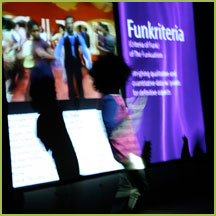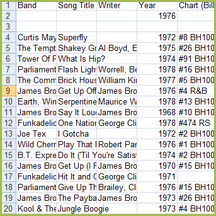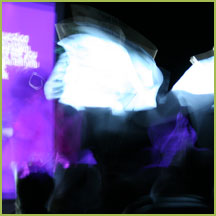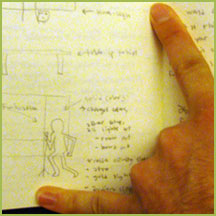Soundscape Jukebox
The Funkuation soundscape features one audio track. This is an original composition made entirely from sound samples no longer than 10 seconds. The mix includes seven hit funk songs, all of which are in the Key of A, each with tempo adjustments to a speed of 108 BPM, thus the name: "Funkin A 108."

select above to view the complete image, or click here

select above to view the complete image, or click here

select above to view the complete image, or click here

select above to view the complete image, or click here

select above to view the complete image, or click here
12/06/09 Cabe Lindsay's Soundscapes Project 03:
The Funkuation
What Did I Make?
1. The Spreadsheet: The Funksheet - a collection of quantitative and qualitative data for 150+ hit funk songs.
2. The Soundtrack: Funkin A 108 - 10 funk hits mixed in samples fewer than 10-seconds, all in the Key of A with tempo adjustments to 108 BPM
3. The Video: The Funkuation - a visual guide to the speech, along with historically-significant dance footage from the TV show, Soul Train, plus screenshots of The Funksheet
Burning Question
This project started with a question: “What happened to the funk music genre?” I had observed some of my favorite modern music players (iTunes, emusic, Pandora, etc.) had excluded the “Funk” genre. At the same time, I was enjoying live performances of funk music, and in fact it is my favorite type of music to dance to. I wondered if I had misconceptions about what the meaning of the word “funk,” and the criteria of what truly defines funk music.
To answer this question, I consulted the UT libraries, and amazingly found only two books in the entire system of multiple libraries. These two books were: (1) Presence and Pleasure: The Funk Grooves of James Brown and Parliament, by Anne Danielsen; and (2) The Funk Era and Beyond: New Perspectives on Black Popular Culture, edited by Tony Bolden. Fortunately, both of these books sufficed. In fact, they were awesomely education and enjoyable. I learned the history of the genre and discovered the definitive aspects of a funk song, and plus gained an idea of what would qualify a “hit” versus a “shit” funk song, all of which helped me prepare for the research project I was about to undertake.
BTW, I figured out the answer to my question: “What happened to the funk music genre?” The answer is that it spun into all sorts of other genres (disco, hip-hop, funkore, etc.), while also staying the same. Quality funk music has persisted through every decade that followed its origin. In my opinion, the truth is that funk music today is as awesome as it ever was. Current funk-based bands such as Breakestra and Sharon Jones And The Dap Kings are producing remarkably good, innovative, danceable funk music. It’s true that the genre termed “funk” is no longer used frequently, and the reason is probably due to the fact that straight-up funk music is less desired by the masses than in it’s heyday (mid-70s). Another reason is because many popular musicians produce funk songs, while including other genres within larger categories such as “Neosoul,” or the all-embracing classic: R&B. Funk still exists today, even in its most organic form, and some of it is fantastic!
The Funksheet
My data analysis project began with a spreadsheet, which I call “The Funksheet.” Click here to view The Funksheet in its current state, as of 12/07/09. To begin my list of songs, I searched Google for “funk list,” “top funk hits,” and such, and then listed every song I could find. I was looking for a big publication, perhaps from Billboard or Rolling Stone magazine, but I mainly found lists compiled by individual people. I cross-referenced various lists of funk hits until I came up with my sample set of 200+ songs.
In The Funksheet, I collected quantitative and qualitative data for each song. The sources of my data include Wikipedia (e.g. ranking on Billboard charts), iTunes (e.g. song length), and beaTunes (e.g. beats per minute). In the earliest stages of this project, I was collecting some of the data by ear, using a melodica or guitar to try and determine the key, for example. I was also measuring tempo with a beatmapping tool. These two aspects (key and tempo) were terribly difficult for me to measure, and required a lot of time. So, I started seeking tools to automate these processes, and that’s where I found beaTunes, which is like a plug-in for iTunes. The beaTunes application really amped up my project.
With this data, I uncovered certain verifiable truths about funk: among the 20+ Keys that define a song’s primary tone, 12.5% of funk hits are in the Key of Em, and the next most popular Keys are A and Dm, both accounting for 10% of all funk hits sampled. I wasn’t sure if this type of information would be valuable to anyone, but I assumed it would lead to some form of treasure. Other types of data led me nowhere, such as word count – the number of words present in the song’s lyrics. Sure, I could figure out a ratio of words to white space (word count per song length), but I’m not sure if that helps anyone to create a “big funkin hit,” which is the goal of The Funkuation.
To collect the qualitative data, I first attempted to define the nature of the song (e.g. sexual, political, etc.). I did this by focusing on the lyrics. I listened intently to each song, and often looked up the written lyrics (from various online sources), and then flagged those with suggestive lyrics as “Sexual,” and then ranked the level of sexual innuendo from “subtle” to “sexxxy,” with the former being least explicit and the latter being most explicit. After completing this process, I found that 48% of all funk hits contained sexually suggestive lyrics, and 14% of those were explicit (e.g. “If I'm In Luck I Might Get Picked Up” by Betty Davis). Keep in mind this is all subjective, and so the sexual overtones based on my own individual taste. I grouped all of the other songs with lyrics into a category called “Expression” (e.g. philosophy, art, drugs), which accounted for 45% of the total. The remaining 7% were instrumental.
My qualitative data collection and analysis got a lot less subjective when I discovered the abundant information available from The Music Genome Project, which identifies the key attributes of millions of songs and then organizes these songs into groups, based on their attributes. This technology is currently used by Pandora (Pandora.com), and this is where I obtained the attribute data for nearly all of the songs on my list.
The Funkuation
At some point in the process, I believed I could identify a mathematical formula for success in composing a hit funk song, and so I started brainstorming ideas for a funkuation (funk equation). My first attempt is this:
Funk = (Bass + Guitar + Drums + Keys + Voice)Artistry * Energy ^ Sex
A big breakthrough arrived as soon as I dipped into the attributes given by The Music Genome Process. Halfway through assembling this data, I started to see that certain songs had a certain “funk sound,” and I used this intuition to develop a point system for the attributes that were definitive funk aspects. Here are my definitive aspects of funk music, articulated by me after cross-referencing multiple sources:
The Funkts (Facts of Funk) - definitive aspects of funk music
- Strong rhythmic groove of electronic bass and drums
- Riff-oriented, based on extended vamp
- Virtually no chord changes
- Instruments played percussively (e.g. slap bass)
- Vocals punctuated w/ screams and grunts
- Sexy, loose, organic, danceable
- Syncopated – emphasis on a beat that is usually not emphasized
- Emphasis on first beat of every measure (downbeat)
Next, I created a list of “Funkriteria” (Criteria of Funk) of The Funkuation. Here, I began to weigh qualitative and quantitative data with points for definitive aspects of a big funkin hit. Here is what I came up with, followed by an explanation and breakdown of each:
The Funkuation = A. Funkuality + B. Funkacteristics + C. Funksessfulness
A. Funkuality (Quality of Funk) – funk format and personality
- 10pts – Funk: straight-up cold, hard, organic or sophisticated
- 9pts – Funksco: funk w/ a hint of disco
- 8pts – Funky Pop: funk w/ a slightly conservative, poppish nature
- 7pts – Jazz: jazzy funk, primarily instrumental
- 6pts – Soul: chord progressions w/ soulful delivery, w/ funk grooves
- 5pts – R&B: chord progressions w/ conservative delivery, w/ funk grooves
- 4pts – Disco: disco w/ funk grooves
- 3pts – Dance: dance w/ funk grooves
- 2pts – Hip-Hop: deejay/emcee w/ funk grooves
- 1pt – Rock: rock w/ funk grooves
B. Funkacteristics (Characeristics of Funk)
- 7pts – flat out funky grooves
- 5pts – heavy syncopation
- 4pts – extensive vamping
- 3pts – funk roots or funk influences
- 2pts – prominent bass riffs
- 1pt – prominent instrument (e.g. percussion, horns, guitar, keys, or vocals)
- -5pts – disco influences
C. Funksessfulness (Successfulness of Funk) – based on chart ranking (Billboard Hot 100, Billboard R&B, Billboard UK, Rolling Stone 500, etc.) and Sales
- 4pts – top 10 placement on Billboard Hot 100 and/or gold sales
- 3pts – placement on Billboard Hot 100
- 2pts – placement on secondary Billboard chart (R&B, UK, etc.)
- 1pt – placement on alternative charts (RS, etc.)
After creating The Funkuation, I had a system of identifying the greatest funk songs of all time, based on impact, attributes, and other characteristics. I used The Funkuation to rank all of the songs on my list, and here are the results:
Funkopitomes (Epitomes of Funk)
10 – “Play That Funky Music” by Wild Cherry
9 – “One Nation Under A Groove” by Funkadelic
8 – “Say It Loud (I'm Black and I'm Proud), Pt. 1” by James Brown
7 – “Serpentine Fire” by Earth, Wind & Fire
6 – “Brick House” by The Commodores
5 – “Get Up Off That Thing” by James Brown
4 – “Flash Light” by Parliament
3 – “What Is Hip?” by Tower of Power
2 – “Shakey Ground” by The Tempations
1 – “Superfly” by Curtis Mayfield
The Funkentation
For my presentation, I created three elements to display The Funksheet: (1) a 7-minute song mixed from samples of hit funk songs; (2) a visual guide to my speech, along with historically-significant dance footage from the TV show, Soul Train, plus screenshots of my Funksheet; and (3) flags for the audience members with the word, “Funki,” written on them.
Regarding the audio portion of my speech, the complete list of 10 songs sampled in “Funkin A 108” include three by Parliament: (1) “Give Up The Funk (Tear The Roof Off The Sucker)”; (2) “Star Child (Mothership Connection)”; and (3) “P. Funk (Wants To Get Funked Up)”; plus (4) “Thank You (Falettinme Be Mice Elf Agin)” by Sly & The Family Stone; (5) “Sexy M.F.” by Prince; (6) “Lovely Day” by Bill Withers; (7) “Sir Duke” by Stevie Wonder; (8) “God Made Me Funky” by The Headhunters; (9) “You Dropped A Bomb On Me” by The Gap Band; and (10) “A Lover’s Holiday” by Change. These songs were selected, in addition to others, because they were all found to be in the Key of A. Prior to this selection, I attempted to mix songs in the Key of C, but it wasn’t fun to me. Before that, I tried to mix a selection of songs that were both similarly Keyed and also similarly Tempoed, but that did not work for me.
Here again is a link to the song in MP3 format: Funkin A 108 (right-click or control-click to download).
Finally, here is a link to the video portion of my presentation: The Funkuation.

 Website designed by Cabe Lindsay of Optimistic Realism. Copyright © 2009 Cabe Lindsay. All rights reserved.
Website designed by Cabe Lindsay of Optimistic Realism. Copyright © 2009 Cabe Lindsay. All rights reserved.